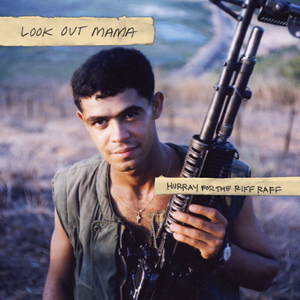 …with digital music files: Cover art. Like the best cover art, that of Hurray for the Riff Raff’s Look Out Mama, released today, has a life of its own. Gregory Good’s cover art invites people to consider the relationship between the phrase and the photo of a young GI in Vietnam. It’s tempting to read the title as a warning, but he doesn’t look malicious. Is he about to rock some woman’s world? Maybe, but the machine gun counteracts any come-on in his eyes. The title and the band’s name appear to be written on masking tape affixed to the photo, as if they constitute homemade cutlines or captions – someone’s private joke or not-that-funny wisecrack.
…with digital music files: Cover art. Like the best cover art, that of Hurray for the Riff Raff’s Look Out Mama, released today, has a life of its own. Gregory Good’s cover art invites people to consider the relationship between the phrase and the photo of a young GI in Vietnam. It’s tempting to read the title as a warning, but he doesn’t look malicious. Is he about to rock some woman’s world? Maybe, but the machine gun counteracts any come-on in his eyes. The title and the band’s name appear to be written on masking tape affixed to the photo, as if they constitute homemade cutlines or captions – someone’s private joke or not-that-funny wisecrack.
I look at the title and hear Bob Dylan’s “Tell Me, Momma” in my head, and the phrase itself is from the first line of Neil Young’s “Powderfinger”: “Look out mama, there’s a white boat comin’ up the river.” The photo resonates with that song and its story of a young man defending the family with his daddy’s gun, but the photo fleshes out Young’s narrative. He sings, “I just turned 22 / I was wondering what to do / and the closer they got / the more those feelings grew,” and the Hurray for the Riff Raff cover could depict the narrator 24 hours earlier. He’s manly, confident and in control when facing a camera.
[youtube]http://www.youtube.com/watch?v=p6xNft9MutQ[/youtube]
Because he’s looking at the camera, he’s looking at you on the cover, and you have to engage his militariness. He’s in uniform and holding a gun. It’s at rest, but it’s there. It’s a part of him in the shot. There’s no flinching from it, no hint of uncertainty or distance. He looks friendly, but he’s a friendly soldier with a gun. The photo doesn’t reduce to his eyes or his smile because his weapon is so present.
On the back cover, singer Alynda Lee Segarra writes that the man is her father somewhere between 19 and 22 (the narrator in “Powderfinger” is 22). Her notes are a call for peace, and the title track sketches in in blues tropes the story of someone shellshocked by sorrow. The song’s narrator might be him, but Segarra wisely doesn’t pin the thought down with rigorous finality. It speaks as she intends about war, fighting and humanity, and the dialogue between the component parts—including the music on the album—is as complex as it is in real life.




